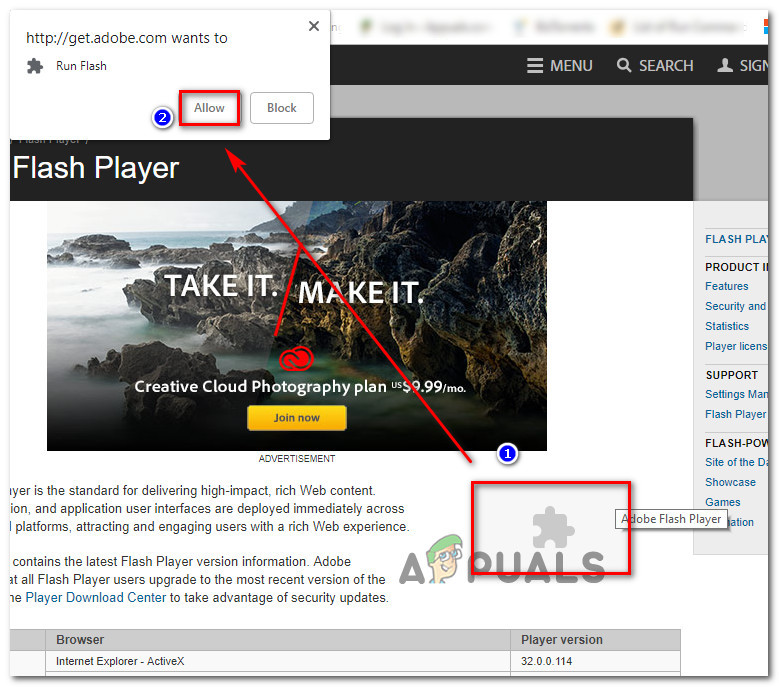What is Flash Player?
Adobe Flash is a now deprecated software platform that used to be extremely popular for production of animation, rich internet applications, mobile apps, desktop apps, mobile games and embedded web browser video players. In the last couple of years, the internet is moving away from Adobe Flash in favor of HTML5 – the latter requires no additional plugins and works with all the latest browsers and devices. In 2017, Adobe announced that it’s preparing to put Flash to rest in 2020. According to the company, 2020 will be the year in which they will cease support, distribution and security updates to Flash Player.
What is causing the ‘Can’t Enable Flash on Chrome’ error?
We investigated this particular error by looking at various user reports and the repair strategies that they used to get the issue resolved. Based on our findings, there are several common scenarios in which this particular issue is reported. If you’re struggling to resolve this particular error message, this article will provide you with a couple of verified repair strategies. Down below, you’ll discover a few potential fixes that other users in a similar situation have used to get his particular issue resolved. If you want to be as efficient as possible, follow the methods presented below in order as they are ordered by efficiency and severity. Let’s begin!
Method 1: Update Chrome to latest version
First things first, let’s start by making sure that Google Chrome is running on the latest version available. Normally, Google Chrome should update itself manually whenever a new version becomes available. But if you keep a Chrome tab opened at all times and you don’t restart your computer frequently, your version might be behind. Luckily, you can force the Chrome client to update itself to the latest version quite easily. This will resolve most bugs related to Flash player that might prevent it from running Flash content. Here’s how to update Chrome to the latest version: If you’re still unable to run Flash content, move down to the next method below.
Method 2: Click on the Flash content to run it
There’s one change that might have confused a lot of users into thinking that Flash is not enabled on their Chrome version. The reason for this is that starting with Chrome v 69, you will need to click on every Flash window to run it regardless of your flash preferences. So, every time you restart the browser, your Flash preferences will be forgotten. This is all part of Google’s plan to make it harder to run Flash content since the end-of-life period is near. With this in mind, click the flash content in order to run it and see if the Flash content is displayed correctly. Simply click on the box with the puzzle icon and then hit Allow to grant the website access to run Flash. If the Flash content is displayed properly after you perform the steps above, then the technology is working as intended. If you’re still unable to view Flash Player content, move down to the next method below.
Method 3: Allowing Flash for the entire website
If you’re visiting a website that is filled with Flash content, clicking on each element individually to run it is hardly an efficient method to go about resolving the issue. In these cases, the best way to enable Flash is to do it for the whole domain. Here’s a quick guide on how to do this: If this method did not enable you to resolve the flash content error, move down to the next method below.
Method 4: Disable Hardware Acceleration
If you’re encountering this issue on a low-spec computer, Flash might be misbehaving due to a conflict with the hardware acceleration feature. Several users that have been struggling to enable Flash content on Google Chrome have finally been able to get the issue resolved by disabling Chrome’s hardware acceleration. Here’s a quick guide on how to do this:
Method 5: Switch to a more permissive browser
If all the methods above have failed you when it comes to enabling Flash on Chrome, it’s time to consider a different browser. Keep in mind that Google Chrome has one of the most aggressive stances when it comes to eradicating Flash, so you can expect things to get even worse in the future. If you’re looking for a browser that doesn’t put this many roadblocks when it comes to running Flash content, we advise you to consider Mozilla Firefox. Firefox will still allow you to keep your user preferences when it comes to Flash and you can also maintain an Allowed-Disallowed list with flash websites.
Fix: Shockwave Flash Crashes in Chrome Windows 10How to Enable or Disable Windows 10 Flash Player on Microsoft EdgeFix: You can’t Install Windows on a USB flash Drive Using SetupHow to Fix Adobe Flash Problems on MacOS El Capitan







